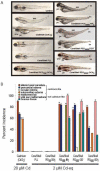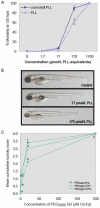Quantum dot nanotoxicity assessment using the zebrafish embryo
- PMID: 19350942
- PMCID: PMC2674626
- DOI: 10.1021/es801925c
Quantum dot nanotoxicity assessment using the zebrafish embryo
Abstract
Quantum dots (QDs) hold promise for several biomedical, life sciences, and photovoltaic applications. Substantial production volumes and environmental release are anticipated. QD toxicity may be intrinsic to their physicochemical properties, or result from the release of toxic components during breakdown. We hypothesized that developing zebrafish could be used to identify and distinguish these different types of toxicity. Embryos were exposed to aqueous suspensions of CdSe(core)/ZnS(shell) QDs functionalized with either poly-L-lysine or poly(ethylene glycol) terminated with methoxy, carboxylate, or amine groups. Toxicity was influenced by the QD coating, which also contributed to the QD suspension stability. At sublethal concentrations, many QD preparations produced characteristic signs of Cd toxicity that weakly correlated with metallothionein expression, indicating that QDs are only slightly degraded in vivo. QDs also produced distinctly different toxicity that could not be explained by Cd release. Using the zebrafish model, we were able to distinguish toxicity intrinsic to QDs from that caused by released metal ions. We conclude that developing zebrafish provide a rapid, low-cost approach for assessing structure-toxicity relationships of nanoparticles.
Figures



References
-
- Gratzel M. Photovoltaic and photoelectrochemical conversion of solar energy. Philos. Transact. A Math. Phys. Eng Sci. 2007;365:993–1005. - PubMed
-
- Nirmal M, Brus L. Luminescence photophysics in semiconductor nanocrystals. Acc. Chem. Res. 1999;32:407–414.
Publication types
MeSH terms
Substances
Grants and funding
LinkOut - more resources
Full Text Sources

